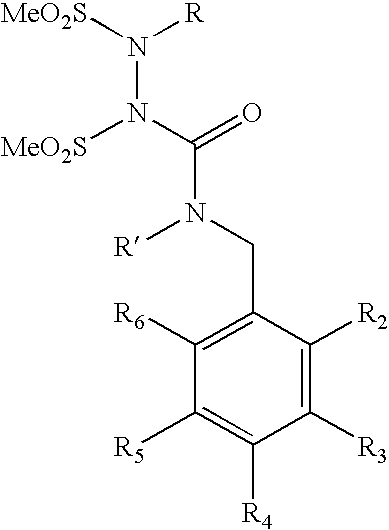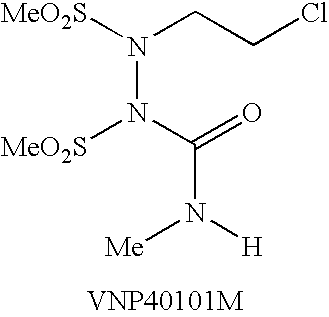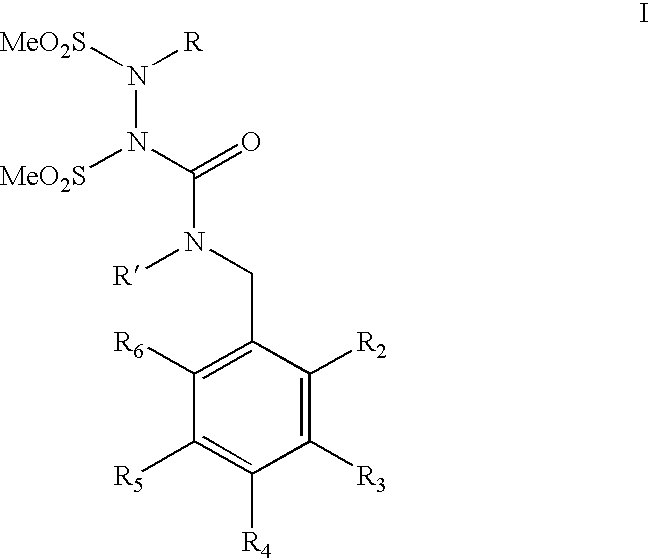Water-soluble shps as novel alkylating agents
a technology of alkylating agent and water-soluble shps, which is applied in the direction of drug composition, peptide, metabolic disorder, etc., can solve the problems of limited clinical usefulness of shps, side effects, hemolysis and phlebitis at high concentrations, etc., and achieves enhanced anti-neoplasia activity, reduced toxicity, and effective compounds
- Summary
- Abstract
- Description
- Claims
- Application Information
AI Technical Summary
Benefits of technology
Problems solved by technology
Method used
Image
Examples
examples 1-3
Preparation of Salicylaldehydes (27a, 27b, 28b) via Formylation of 4-Substituted Phenols (Duff Formylation)
[0092] General procedure. To a solution of the appropriately substituted phenol (10.0 g) in TFA (100 mL) was added HMTA (1.1 equivalent) in small portions. The reaction solution was heated at reflux overnight. After cooling, the solution was treated with 50% H.sub.2SO.sub.4 solution (40 mL) for 4 h at room temperature, and then was extracted with ether (3.times.100 mL). The combined ether phases were washed with 5 M HCl solution and water, and then dried over anhydrous MgSO.sub.4. After filtration, the filtrate was evaporated and purified.
[0093] 2-Hydroxy-5-trifluoromethyl-benzaldehyde (27a). Following the general procedure and FCC purification with 30% ethyl acetate-hexane, 4-trifluoromethyl phenol (10.0 g, 61.7 mmol) gave 2-hydroxy-5-trifluorome-thyl-benzaldehyde 27 (3.9 g, 34%) as a pink solid.
[0094] Rf (20% ethyl acetate-hexane): 0.47.
[0095] .sup.1H NMR (300 MHz, CDCl.sub.3...
examples 4-6
Preparation of Diethylphosphonoxy-benzaldehydes (23, 24a-b) from Phenolic Aldehydes
[0104] General procedure. To a stirred ice-cold solution of the appropriately substituted aldehyde (10.0 g) in acetonitrile (120 mL) was added diethyl chlorophosphate (1.1 equivalent) and TEA (1.1 equivalent). The reaction mixture was kept at room temperature overnight. After removal of the precipitate by filtration, the filtrate was evaporated and dried. The crude diethylphosphonoxy-benzaldehyde could be used without further purification.
[0105] 4-Diethylphosphonoxy-benzaldehyde (23). Following the general procedure, 4-hydroxybenzaldehyde (9.0 g, 73.8 mmol) was converted to 4-diethylphosphonoxy-benzaldehyde 23 (18.9 g, 99%) isolated as a light yellow oil.
[0106] .sup.1H NMR (300 MHz, CDCl.sub.3) .delta. 9.98 (s, 1H, CHO), 7.91 (d, J=9.0 Hz, 2H, C3-H (Ph)), 7.39 (d, J=8.4 Hz, 2H, C2-H (Ph)), 4.26 (m, 4H, CH.sub.2) and 1.38 (t, J=6.9 Hz, 6H, CH.sub.3).
[0107] .sup.13C NMR (75 MHz, CDCl.sub.3) .delta. 190....
examples 7-9
Preparation of 4-Chloro-2-diethylphosphonoxy-benzaldehyde (24c) from 4-Chlorosalicylic Acid
[0120] 5-Chloro-2-hydroxymethyl-phenol (25). A solution of 4-chloro salicylic acid (10.0 g, 58.0 mmol) in THF (150 mL) was treated with LAH (1.5 equivalent) at reflux for 2 h. After cooling to ambient temperature, the reaction solution was quenched by 1 N NaHSO.sub.4 solution (200 mL), and then extracted with ether (300 mL). After separation, the organic layer was dried over anhydrous MgSO.sub.4, filtered and concentrated. The dried crude product 25 (7.5 g, 81%) was obtained as a gray solid, and was pure enough for use without further purification.
[0121] .sup.1H NMR (300 MHz, DMSO-d.sub.6) .delta. 9.85 (s, 1H, Ph-OH), 7.27 (d, J=8.2 Hz, 1H, C3-H (Ph)), 6.81 (d, J=8.2 Hz, 1H, C4-H (Ph)), 6.78 (s, 1H, C6-H (Ph)), 5.03 (m, 1H, OH) and 4.41 (d, J=4.1 Hz, 2H, PhCH.sub.2).
[0122] .sup.13C NMR (75 MHz, DMSO-d.sub.6) .delta.155.0, 131.0, 128.6, 128.0, 118.5, 114.2 and 57.7.
[0123] 4-Chloro-2-diethylphos...
PUM
| Property | Measurement | Unit |
|---|---|---|
| Volume | aaaaa | aaaaa |
| Time | aaaaa | aaaaa |
| Time | aaaaa | aaaaa |
Abstract
Description
Claims
Application Information
 Login to View More
Login to View More - R&D
- Intellectual Property
- Life Sciences
- Materials
- Tech Scout
- Unparalleled Data Quality
- Higher Quality Content
- 60% Fewer Hallucinations
Browse by: Latest US Patents, China's latest patents, Technical Efficacy Thesaurus, Application Domain, Technology Topic, Popular Technical Reports.
© 2025 PatSnap. All rights reserved.Legal|Privacy policy|Modern Slavery Act Transparency Statement|Sitemap|About US| Contact US: help@patsnap.com



